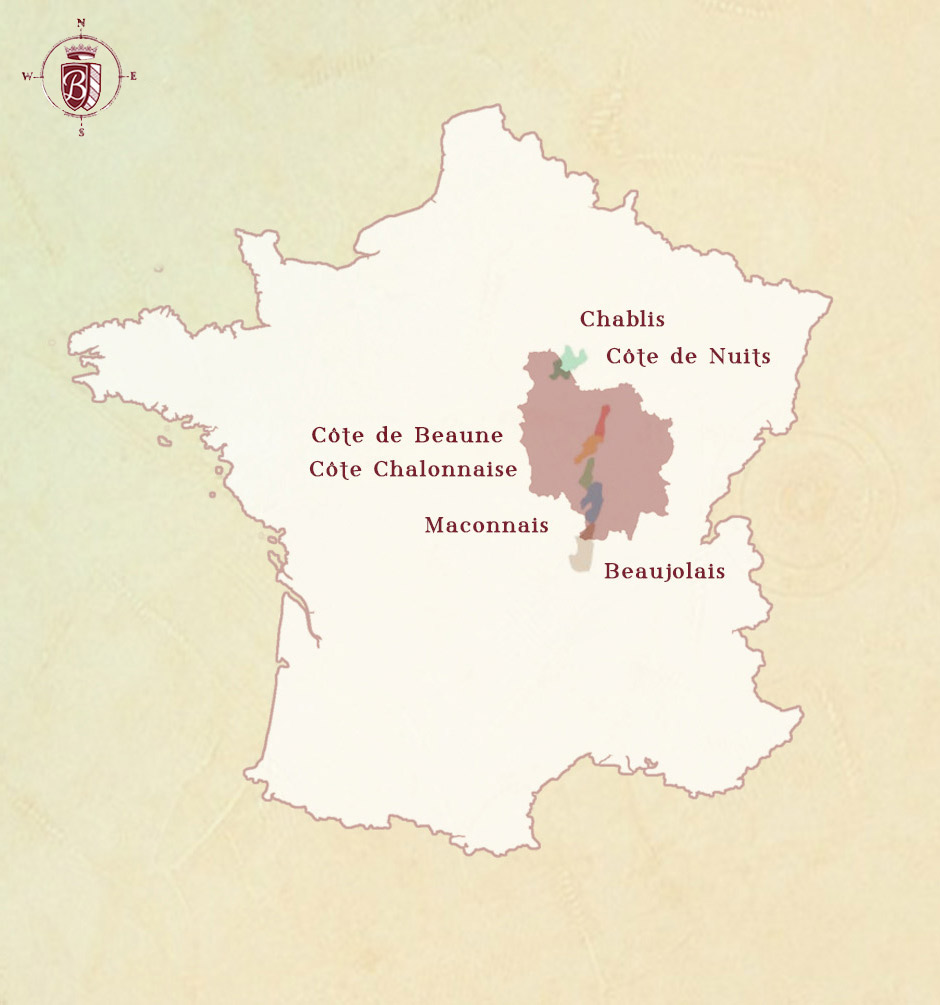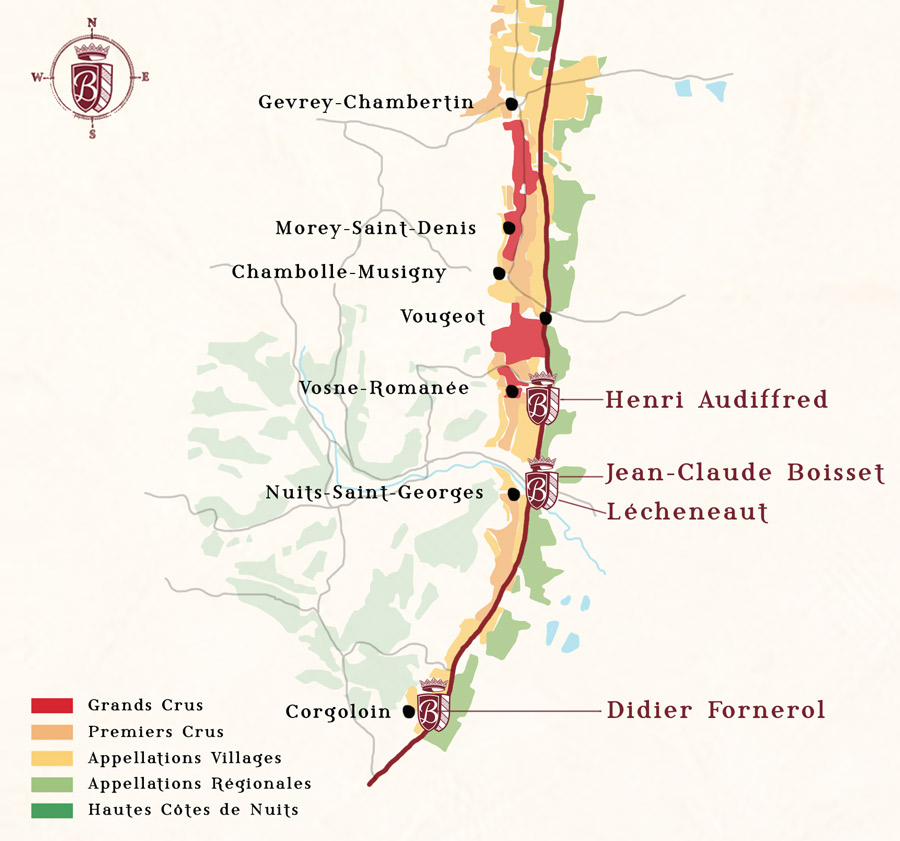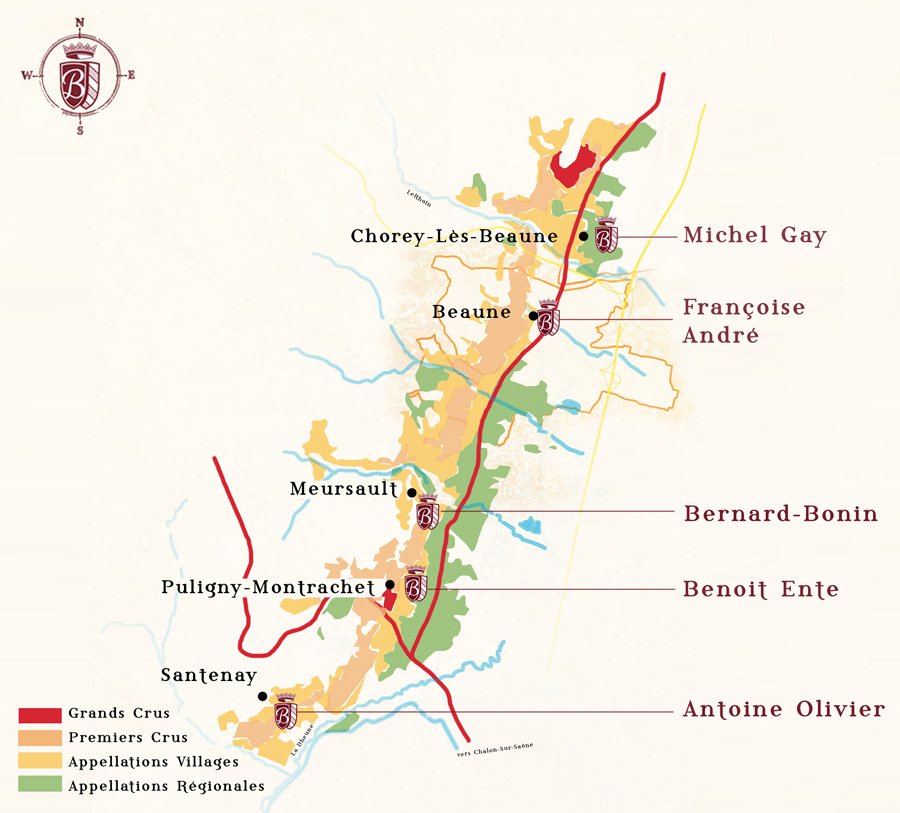Burgundy, the heart of France
Burgundy, a place with a unique heritage, is ideally situated. It has always enjoyed a strategic position. Since the Middle Ages, Burgundy has been located on a primary commercial axis linking Northern Europe with the Mediterranean Basin and a historical trading route between the Rhone Valley and the Paris Basin.
Burgundy is 150km long and enjoys a climate that is particularly well-suited to vine cultivation. The convergence of Mediterranean, continental and oceanic influences plays a major role in terms of the aromatic richness and global reputation of its wines.
Burgundy is the result of “meetings and crashes” when the growth of the European Alps hit the Bressan plaque. This tectonic movement ended up into a “crash” creating several “seizures” or geological faults. Each of those are now a wine-producing areas )listed from north to south): Chablis & Grand Auxerrois, Côte de Nuits, Côte de Beaune, Côte Chalonnaise, Maconnais and Beaujolais.

Chablis
The Chablis vineyard is made up of hills bordered by the Serein valley. This hilly and wooded region is anchored in a clay-limestone soil that belongs to the Jurassic, especially the Kimmeridgian for the best terroirs. This is what makes the finesse and righteousness of Chablis wines.
Location:
Located near Auxerre in the department of Yonne, the Chablis vineyards lie along a little river aptly named the Serein (“serene”). Vines began to grow there during the Roman era. In the 12th century, the Cistercian monks from the abbey of Pontigny developed its cultivation. The AOC Chablis status was created in January 1938, thus confirming the excellent qualities of this dry white wine that unlike the wines of some other regions has held its leading place throughout history thanks to the high quality of its raw material – the Chardonnay grape.
Soils:
The main substrate is Jurassic limestone (specifically, Kimmeridgian limestone) laid down some 150 million years ago. The rock contains deposits of tiny fossilised oyster shells reminding us that Bourgogne once lay beneath a warm ocean. Some particularly valuable Climats produce the Premier Cru.
Irancy:
Located 20 km south-west of Chablis, the Appellation of Irancy is very much “under the radar” and unique as it has been making red wine only for the last 2,000 years! Wines which deserve a close attention as they represent great value for money.

Côte de Nuits
This is the best of Burgundy production for red wine. For nearly two thousand years, these vineyards have contributed to the worldwide reputation of the whole of Burgundy. The area stretches between Dijon and Corgoloin (35 km) on a narrow strip of gentle slopes of about twenty kilometers long and only 200 to 300 meters wide.
Soils:
The notions of Terroirs, climate, soil and “Clos” and “Climats” (as we say in Burgundy) exploited since the 10th century by the monks, take here their full meaning. The continental climatic influence, the perfect adaptation of the Pinot Noir grape to limestone and clay soils, the good exposure of the vine and the absence of streams and rivers create an ideal environment.
The most famous appellations are: Gevrey Chambertin, Morey-Saint-Denis, Chambolle-Musigny, Vosne-Romanee, Nuits-Saint-Georges …

Côte de Beaune
Location:
In the southern extension of Cote de Nuits (linked), here is Beaune: the capitcal of the wine trade in Burgundy! On a 25 km stretch between Ladoix and Maranges you will find some of Burgundy’s jewels both for red and white wines.
Soils:
The soils are made up of limestones, clay and marls. The hot and dry climate makes for the good ripening of the grapes. Rivers are more numerous than in Cote de Nuits. The “Climats”, and Terroirs were delimited by the Benecditin and Cisterian monks, same as for Cote de Nuits.
This part of the vineyard excels both in white and red. All the Appellations produce both red and white wines except for Volnay and Pommard which produce only reds.
The best known appellations are Meursault, Puligny-Montrachet, Corton-Charlemagne, Beaune, Pommard, Volnay, etc.

Côte Chalonnaise
Location:
25 kms long and 7kms wide, located between the coast of Beaune and the mountains of Maconnais to the south, this natural extension of the Cote de Beaune and cote de Nuits is one of the most beautiful wine regions of Burgundy.
Soils:
Its soils are made of clay limestone.
The main Appellations are: Rully, Mercurey, Montragny, Givry and Bouzeron. They represent excellent value for money as the wine quality has been on the rise for some time and prices remain affordable.

Mâconnais & Crus du Beaujolais
Location:
It is the southern border of Burgundy, which stretches for 35 kilometers between Sennecey-Le-Grand and Saint-Véran and is 10 kilometers wide between the valleys of Grosne and Saone. The vineyards are located on hills facing east and south-east.
Soils:
The Maconnais is mostly a white wine area with great (and under-estimated) Terroirs for Chardonnay. This is where Macon, Macon-Villages, Pouilly-Fuissé, Pouilly-Loché, Pouilly-Vinzelles and Saint-Véran appellations are located. Some of them, combined with excellent viticulture and winemaking skills can compete against the best white wines of Cote de Beaune. A must try!
Bear in mind that 70 years ago, these “Crus” were considered as “Grands Crus” of South Burgundy and were well recognized and appreciated! Historical records show us that a barrel of Moulin à Vent, Fleurie, Morgon or Chénas used to be sold at the same price as Cote de Nuits’ great wines: Gevrey-Chambertin, Vosne-Romanée and Clos de Vougeot.
After a difficult time – the creation of the “Beaujolais Nouveau” event, which completely brought down the quality of Beaujolais’ wines – the “Crus du Beaujolais” are now on the rise and some of them can, again, reclaim their status of “Grands Crus” of South Burgundy!
Location:
From the southern part of Macon up to the Lyon suburbs, the Beaujolais is an integral part of what we call “great Burgundy”. The Crus du Beaujolais are located in the northern part of the region. Some Crus like Saint-Amour literally touch the Appellations of Pouilly-Fuissé and Saint-Véran.
Soils:
The terroirs are made of granite and sand. This forces the vine to descend even deeper to get the expression of its origin.
Each Cru has its own specific Terroir and identity, making all of them unique!

Introducing Other Regions
Loire Valley:
The Loire Valley wine region is one of the world’s most famous area for wine production and includes several French wine regions situated along the river from the Muscadet region on the Atlantic coast to the regions of Sancerre and Pouilly-Fumé, just southeast of the city of Orléans in north central France. Loire wines tend to exhibit a characteristic fruitiness with fresh, crisp flavors.
Centre Loire Valley;
The Loire Valley wine region is one of the world’s most famous area for wine production and includes several French wine regions situated along the river from the Muscadet region on the Atlantic coast to the regions of Sancerre and Pouilly-Fumé, just southeast of the city of Orléans in north central France. Loire wines tend to exhibit a characteristic fruitiness with fresh, crisp flavors.
Quincy and Reuilly:
This is where Sauvignon Blanc has its origin! French king Charles VII used to drink the “Smoked white of Quincy!” back in the XVth century.
These two Appellations are well known in France despite the fame of their neighbors: Sancerre and Pouilly-Fumé.
Quincy has Terroirs made up of gravels and sandy soils.
Reuilly has exceptional and undiscovered Terroirs with gravels, marls, clay and limestone! Pinot Noir, Pinot Gris and Sauvignon Blanc can express their best!
Côtes du Roussillon:
Côtes du Roussillon are very old vineyards located at the South East part of the Pyrenees mountains, in the Catalan country on the border between France and Spain.
Like in the Rhône valley, Roussillon winemakers produce wines made out of Syrah, Grenache and Carignan.
Nowadays, due to global warming, the best producers are located in altitude to avoid the summer heat and get cooler nights in order to obtain more balanced wines.
Jura:
Jura is a region that belongs to Switzerland and France. Wines of Jura are produced in the Jura département. Located between Burgundy and Switzerland, the cool climate produces wines with some similarity to Burgundy and Swiss wine. Jura wines are distinctive and unusual wines, the most famous being vin jaune, which is made by a similar process to Sherry, developing under a flor-like strain of yeast. This is made from the local Savagnin grape variety.
Other grape varieties include Poulsard, Trousseau, and Chardonnay. Other wine styles found in Jura includes a vin de paille made from Chardonnay, Poulsard and Savagnin, a sparkling Crémant du Jura made from slightly unripe Chardonnay grapes, and a vin de liqueur known as Macvin du Jura made by adding marc to halt fermentation.
Nowadays, wine lovers hunt of Jura’s wines in quest of stunning aromatic complexity as well as food and wine pairings.


